Lemon pesto is a twist on traditional basil pesto, which is a bright, pungent and flavorful sauce hailing from the heart of Italian cuisine.
Pesto has deep roots dating back to Roman times, where a similar sauce known as Moretum was made using garlic, herbs, cheese and olive oil. The name “pesto” itself originated in Genoa, Italy around the 16th century and comes from the Italian verb “pestare” meaning “to pound” or “to crush,” indicating the original method of making pesto in a marble mortar with a wooden pestle.
A classic pesto recipe includes ingredients such as fresh basil, pine nuts, Parmesan cheese, garlic and olive oil, but our version of lemon pesto deviates from the traditional way by adding lemon zest and juice. This gives the sauce a bright, citrusy hue and makes the flavor more summery and fresh.
Any pesto sauce is versatile. You can pour it over roasted vegetables, add it to pasta, spread it on sandwiches or even use it as a marinade for chicken and fish.
Contents

⏱ Cooking time — 15 minutes overall. Includes 15 minutes of preparation and cooking + 0 minutes unattended.
🔪 Ingredients
For 4 servings:
- 70 g (2 ½ oz) fresh basil (large bunch)
- 3 garlic cloves
- 1 lemon (juice + zest)
- 50 g (1 ¾ oz) parmesan cheese
- 50 g (1 ¾ oz) pine nuts
- 100 ml (6 ¾ tbsp.) olive oil extra virgin
- 1 tsp. salt
- black pepper
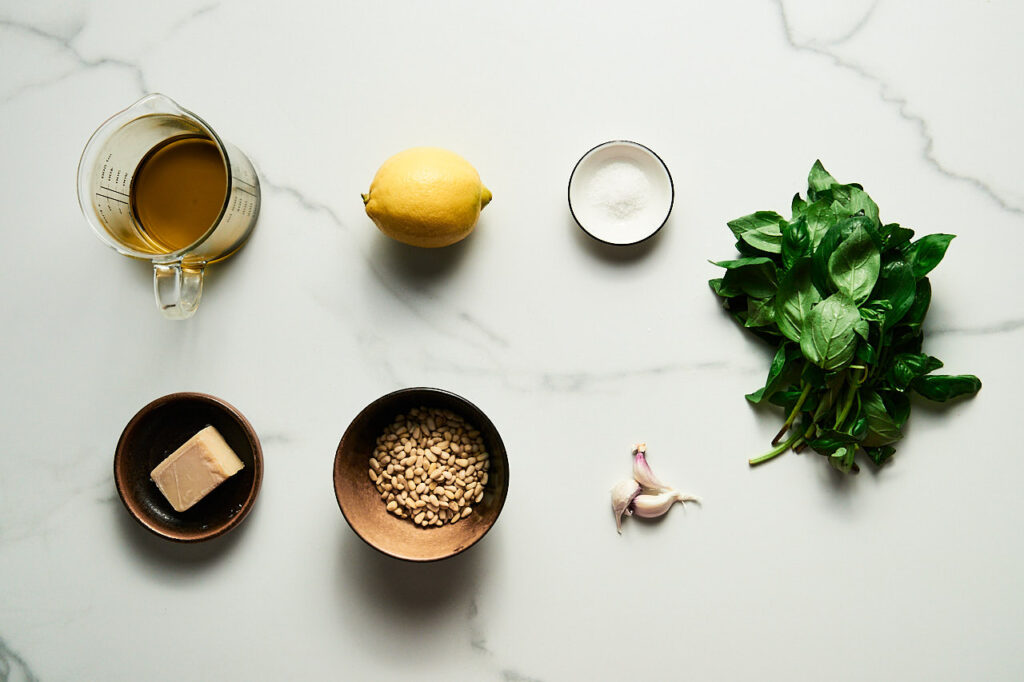
🥣 Directions
Roasting pine nuts
Start by roasting 50 g (1 ¾ oz) of pine nuts.
Heat a dry skillet over medium heat, add the nuts and roast until golden for about 3 minutes, stirring frequently.
Remove the skillet from the heat and set aside, the pine nuts will still continue to finish, so during the first 5 minutes of the skillet cooling, don’t be lazy and stir them 3-4 more times.
Preparing the basil and lemon
Take a large bunch of fresh basil (70 g (2 ½ oz)) and chop it randomly with a knife into 4-5 pieces, for convenience.
Put the chopped basil in the bowl of a blender or a tall glass.
Take 1 lemon and grate the zest from it on a fine grater into the same glass. Cut the lemon in half and squeeze the juice from it into the same. If you have a small lemon, you can squeeze all the juice at once, but if you have a large or medium-sized lemon, squeeze half of it, make the pesto, and then add more lemon juice to your taste so that you don’t overdo it.
Adding the rest of the ingredients
Grate 50 g (1 ¾ oz) of parmesan cheese on a fine grater and add to the rest of the ingredients.
Crush 3 garlic cloves with the flat side of a knife, peel and place in the blender bowl.
Add the roasted pine nuts and half (50 ml) of the olive oil.
Preparing the pesto
Chop all ingredients with a blender.
When the ingredients begin to combine, continue to whisk, slowly pouring in the remaining olive oil in a thin stream.
To finish cooking
Taste the pesto, add 1 tsp. salt and freshly ground black pepper to taste. Also add a little more lemon juice if necessary.
Whisk everything together again.
Transfer the pesto to a jar for storage or use immediately.
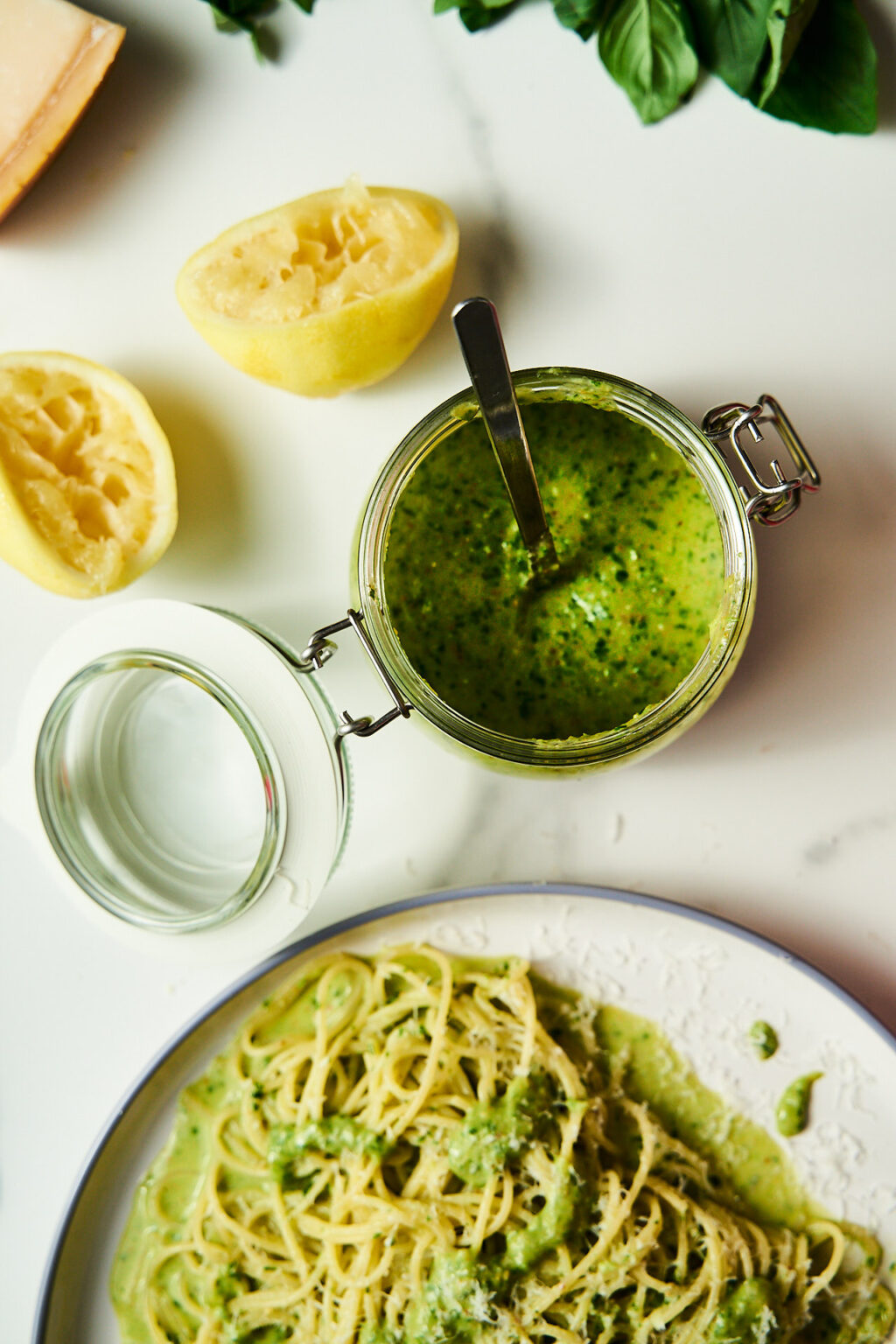
How to Use Lemon Pesto?
- Pasta Dressing: Toss your cooked pasta in lemon pesto. The zestiness of the lemon beautifully complements both whole wheat and white pasta. You can add roasted vegetables or grilled chicken for a heartier meal.
- Sandwich Spread: Instead of the usual mayo or butter, spread a generous layer of lemon pesto on your sandwich bread. Whether you’re making a vegetable sandwich, chicken, or even a simple cheese toast, the pesto adds a burst of flavor.
- Salad Dressing: Mix lemon pesto with a little more olive oil and lemon juice, and you have a delicious salad dressing. Drizzle it over greens, cherry tomatoes, olives, and feta for a Mediterranean-style salad.
- Marinade: Use lemon pesto as a marinade for meats like chicken, fish, or even tofu. Let the protein soak in the marinade for a few hours, and then grill or bake.
- Pizza Base: Spread lemon pesto over your pizza dough before adding the toppings. It pairs well with mozzarella, fresh tomatoes, arugula, and grilled chicken.
- Dip: Serve lemon pesto as a dip alongside freshly baked bread, crackers, or vegetable sticks. It can be a hit in parties and gatherings.
- Topping for Roasted Vegetables: After roasting vegetables like bell peppers, zucchini, and eggplants, drizzle some lemon pesto on top. It elevates the flavor profile of the veggies.
- In Soups: Stir in a spoonful of lemon pesto into soups, especially tomato-based or vegetable soups, for an added depth of flavor.
- With Eggs: Swirl some lemon pesto into your scrambled eggs or spread it on top of a sunny-side-up. It gives a zesty kick to start your day.
- On Toast: A simple yet delicious breakfast option is to spread lemon pesto over toast. Add some sliced avocados or tomatoes for a wholesome meal.
🙋♂️ FAQ
Can I use other types of nuts instead of pine nuts?
Yes, if pine nuts are not available or you prefer another type, you can substitute them with almonds, walnuts, or cashews. The flavor will slightly change depending on the nuts used, but it will still be delicious.
How can I store this pesto?
This lemon pesto can be stored in an airtight container in the refrigerator for up to a week. You can also freeze it in ice cube trays, then transfer the cubes to a freezer bag for longer storage, up to 3 months.
Is this recipe suitable for vegans?
The recipe as it stands is not vegan due to the use of parmesan cheese. However, it can be made vegan by using a vegan cheese substitute or nutritional yeast in place of the parmesan.
Can I use dried basil instead of fresh?
Fresh basil is highly recommended for this recipe as it provides a vibrant flavor that dried basil can’t match. If fresh basil is not available, consider using a different fresh herb like parsley or cilantro instead.
Can I use a blender or food processor to make this pesto?
Yes, you can use either a blender or a food processor to make this pesto. Both will help you achieve a smooth and creamy texture.
What other uses are there for this Lemon Pesto with Basil, Pine Nuts, and Parmesan, apart from pasta?
This pesto is versatile and can be used as a spread on sandwiches, a dressing for salads, a marinade for chicken, fish, or vegetables, or even as a dip for bread or crackers.
Can I use lime instead of lemon?
While the recipe calls for lemon, you can substitute it with lime for a different but equally refreshing flavor. Be aware that lime has a stronger flavor, so you may need to adjust to taste.
What can I do if my pesto is too thick?
If your pesto is too thick, you can thin it out by adding more olive oil, a bit at a time, until it reaches your desired consistency.
Can I add other herbs to this pesto?
Yes, feel free to experiment with adding other herbs to this pesto. However, keep in mind that basil should still be the dominant flavor. Good additions might include a bit of mint, parsley, or even arugula.
Can I use store-bought lemon juice instead of fresh lemons?
Fresh lemon juice is recommended for its vibrant flavor, but you can use store-bought lemon juice in a pinch. The flavor might be slightly different and less bright than fresh lemons.
Is this recipe keto-friendly?
Yes, this pesto is high in healthy fats from the pine nuts and olive oil, and low in carbs, making it suitable for a ketogenic diet. However, be aware that the Parmesan cheese does contain some carbs.
What can I do if my pesto is too bitter?
If your pesto turns out too bitter, it could be due to the olive oil or the pine nuts. Try adding a bit more Parmesan cheese or a small amount of honey or sugar to balance out the bitterness.
Can I use this pesto as a pizza sauce?
Yes, this lemon pesto can be used as a delicious and unique pizza sauce. It pairs well with a variety of toppings such as grilled chicken, fresh tomatoes, and mozzarella.
How do I know when the pesto has gone bad?
Pesto that has gone bad may have a sour smell or an off taste. If you see any signs of mold or the pesto has been stored for longer than recommended, it’s best to discard it.
Can I use this pesto as a marinade?
Yes, this lemon pesto can be an excellent marinade for meats, fish, and vegetables. Simply let your chosen ingredients marinate in the pesto for at least an hour before cooking.
📌 Pin it!
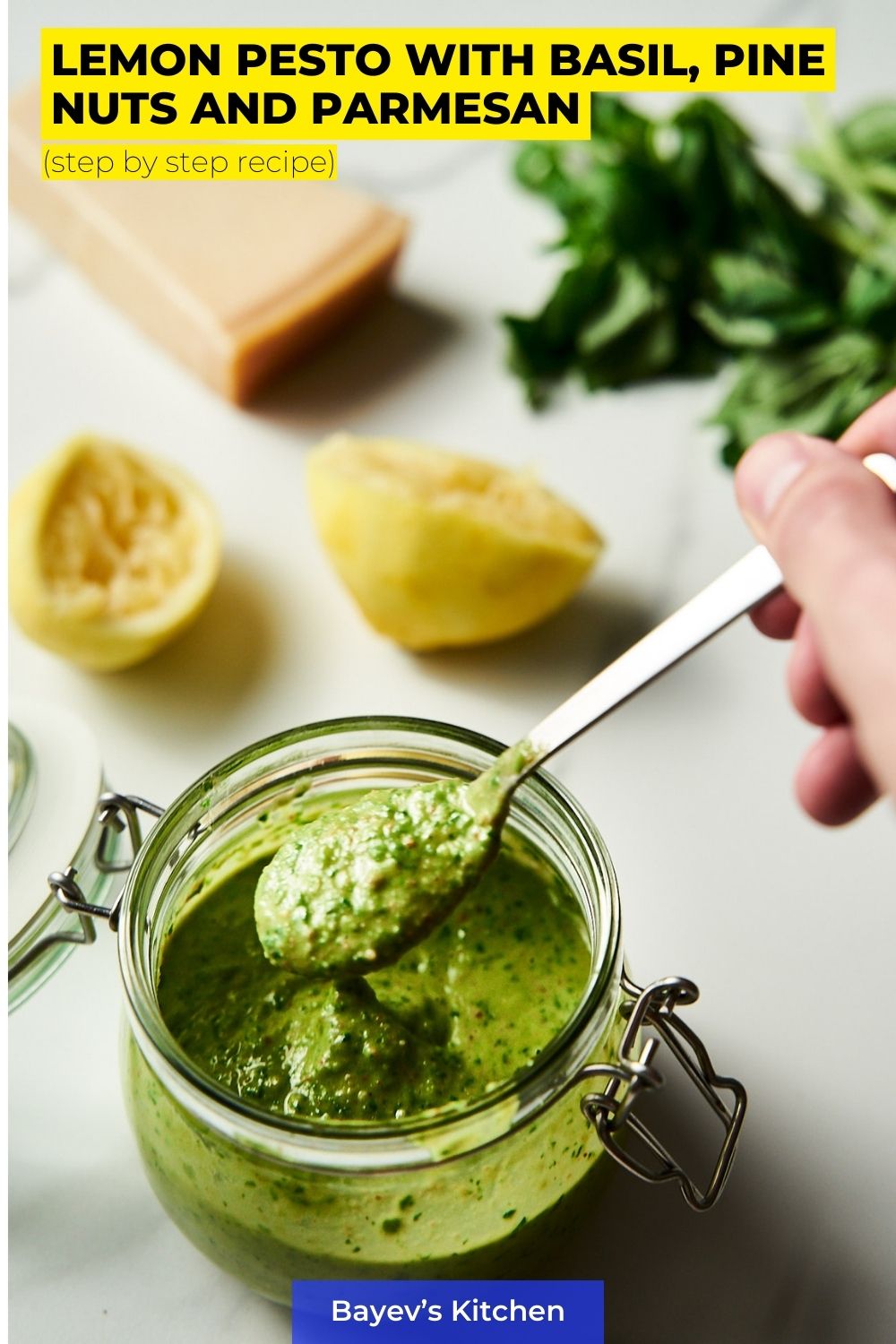
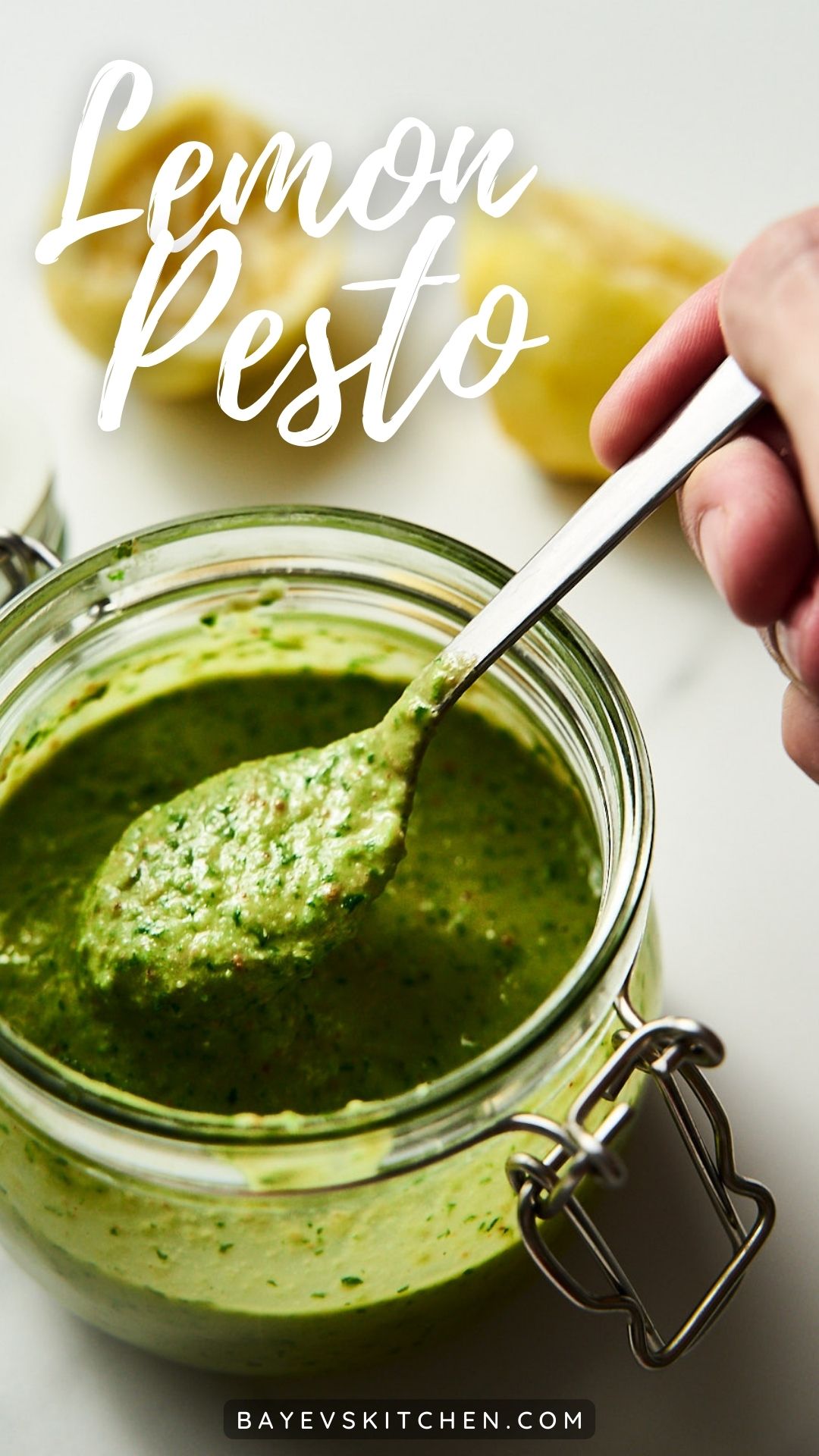
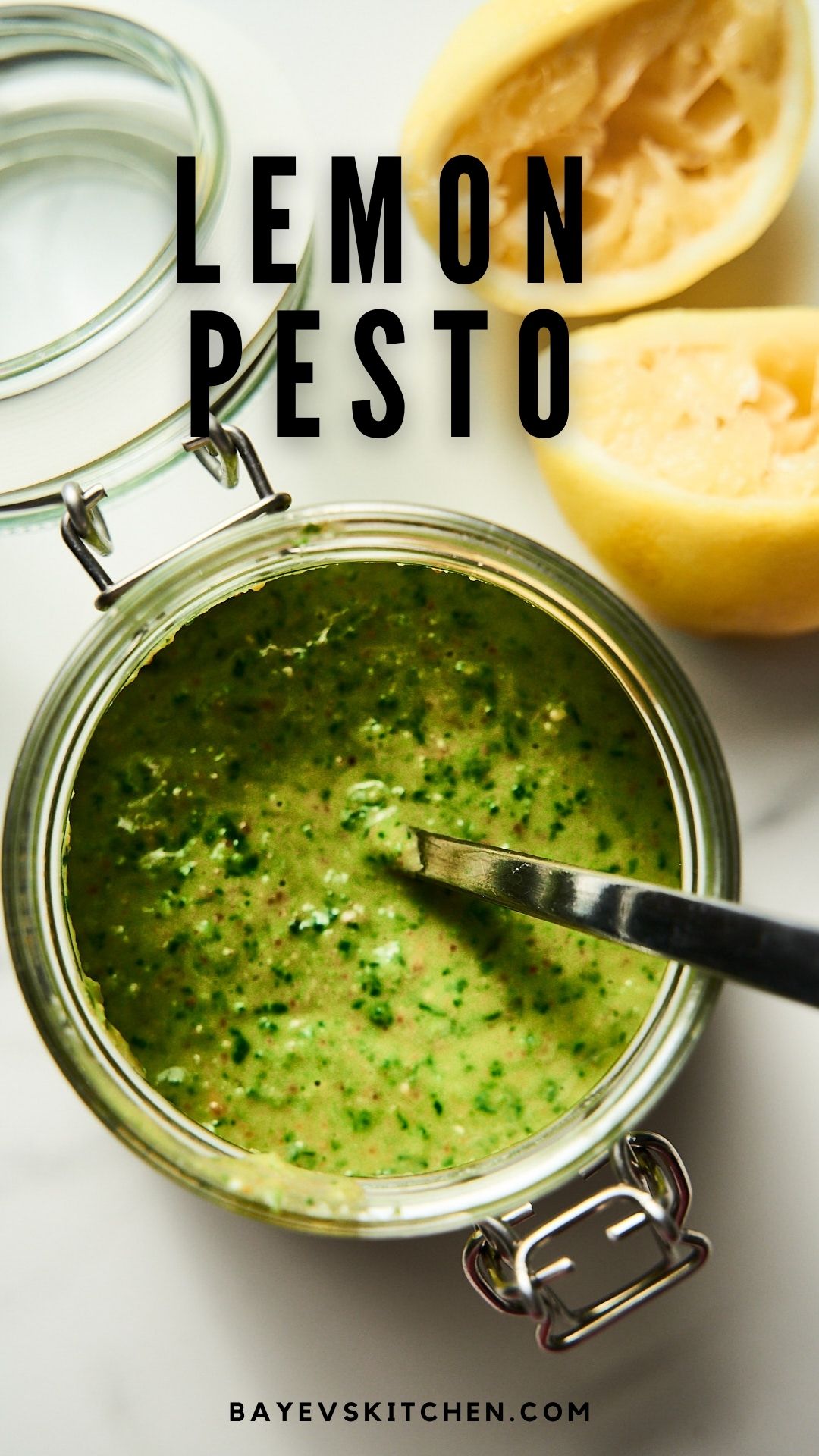

Lemon pesto with basil, pine nuts and parmesan
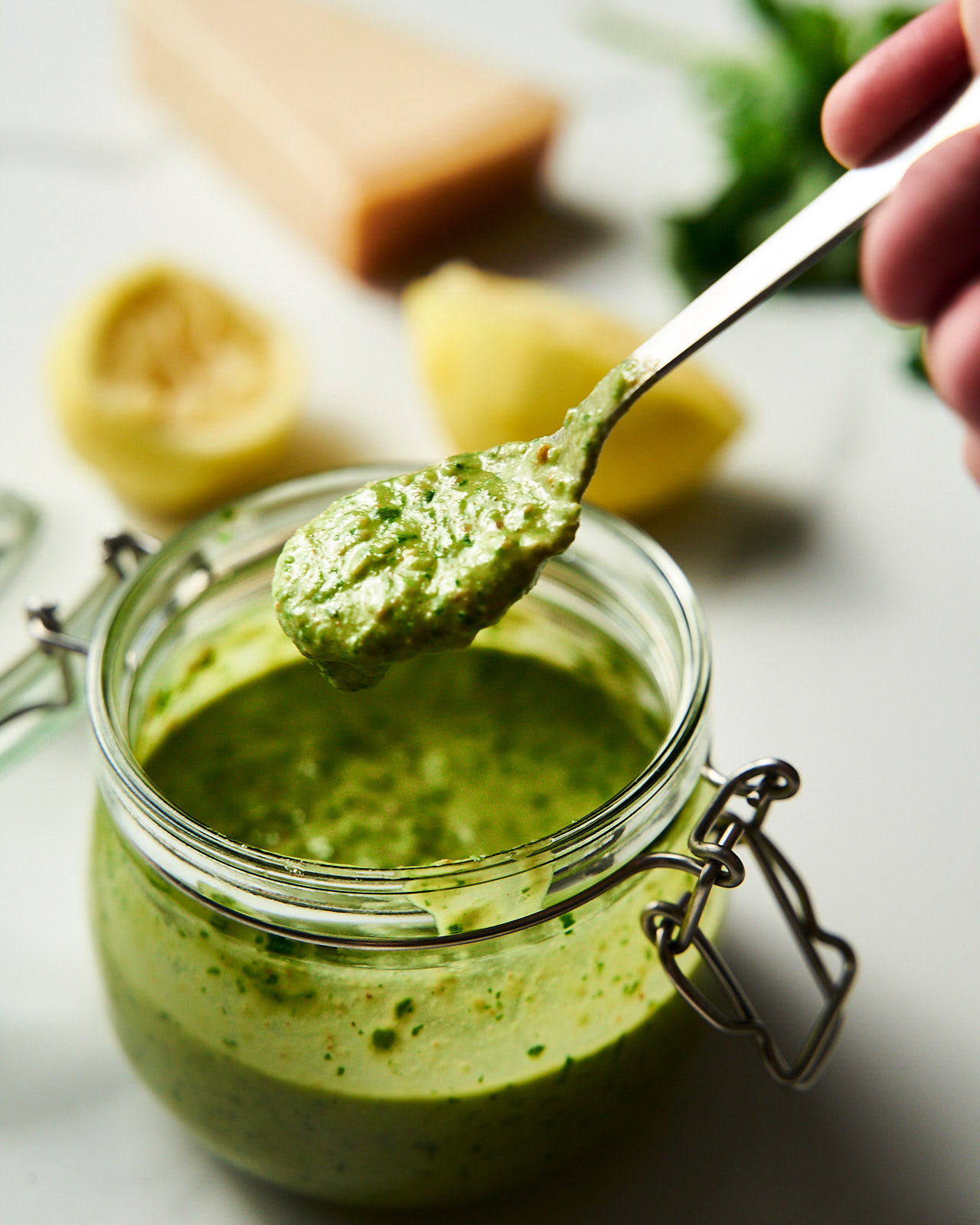
Ingredients
- 70 g fresh basil (large bunch)
- 3 garlic cloves
- 1 lemon (juice + zest)
- 50 g parmesan cheese
- 50 g pine nuts
- 100 ml olive oil extra virgin
- 1 tsp. salt
- black pepper
Instructions
- Roast the pine nuts over medium heat until golden, stirring frequently. Allow them to cool.
- Chop the basil randomly with a knife into 4-5 pieces and place in a blender. Grate the zest of the lemon and squeeze its juice. Add to the blender.
- Grate the parmesan on a fine grater and add to the blender. Add the peeled garlic cloves and toasted pine nuts. Add half of the olive oil.
- Grind all ingredients in a blender, slowly adding the remaining olive oil.
- Add salt and black pepper to taste. Add a little more lemon juice if necessary. Whisk everything together once more. Transfer the pesto to a jar for storage or use immediately.
